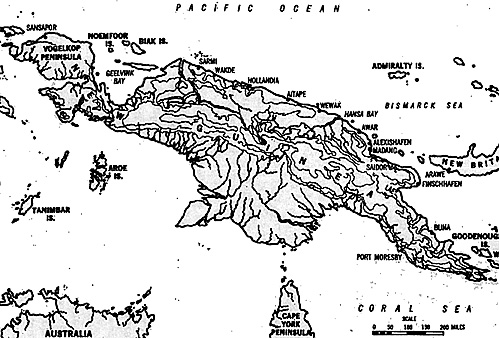On 22 April 1944, the Allies invaded Aitape, New Guinea. This invasion, far to the rear of the Japanese, was made possible by information received from Ultra Intelligence. Ultra Intelligence was the cover for the U. S.'s ability to read the Imperial Japanese Army's most secret codes. This information told General Douglas MacArthur the strengths and dispositions of the Japanese units. More importantly, it told him where the Japanese thought the Allies would attack and the Japanese plans for defeating those invasions.
The landings at Aitape were made to capture the airbases being built by the Japanese. These airbases would allow the Allies to provide close air support to the invasion of Hollandia, which was the main objective. To protect Aitape, a covering force was positioned along the Driniumor River to the east. This covering force was to stop the Japanese 18th Army, commanded by Lt. General Adachi Hatazo. The 18th Army was stationed between Wewak and Awar. Wewak was 500 kilometers from Aitape.
The following article covers the initial breakthrough by the Japanese on 10/11 July 1944. It is taken from the Leavenworth Papers Defending the Driniumor:: Covering Force Oprations in New Guinea, 1944, by Dr. Edward J. Drea. The troops along the Driniumor were supposed to be a covering force. Doctrine defined a covering force as "a defensive line to provide time for the main force to prepare itself for combat, to deceive the enemy as to the actual location of the main battle position, to force the enemy to deploy early, and to provide a deeper view of the terrain over which the attacker would advance. If forced to withdraw, the covering force was expected to fight a delaying action against the enemy attacker."
The American forces were not allowed to withdraw, but instead were rushed into a series of hasty counterattacks in dense jungle. After the breakthrough, the Americans launched a two pronged counterattack from the north and south, meant to seal the break in the lines. This attack ran into additional Japanese units fighting to reinforce and maintain the initial break in the American lines. After both attacking forces bogged down, the fight settled into a battle of attrition.
Fortunately, the Japanese were just as confused as the Americans as to what the actual situation was. This, combined with the poor physical condition of the Japanese troops, lack artillery or air support, and an almost total lack of food and other supplies, helped the Americans to win the fight.

112th US Cavalry 1944 Covering Force in New Guinea
-
Introduction
Druniumor: 18th Army Prepares to Attack
Breakthrough of the Japanese Attack
US Counterattack at Afua
TO&E vs. Actual Unit Strengths
US and Japanese TO&Es (slow: 98K)
Jumbo Map of New Guinea (slow: 192K)
Back to Table of Contents -- Combat Simulation Vol 2 No. 2
Back to Combat Simulation List of Issues
Back to MagWeb Magazine List
© Copyright 1995 by Mike Vogell and Phoenix Military Simulations.
This article appears in MagWeb (Magazine Web) on the Internet World Wide Web.
Other military history articles and gaming articles are available at http://www.magweb.com